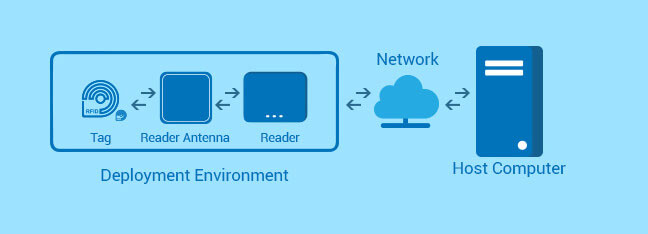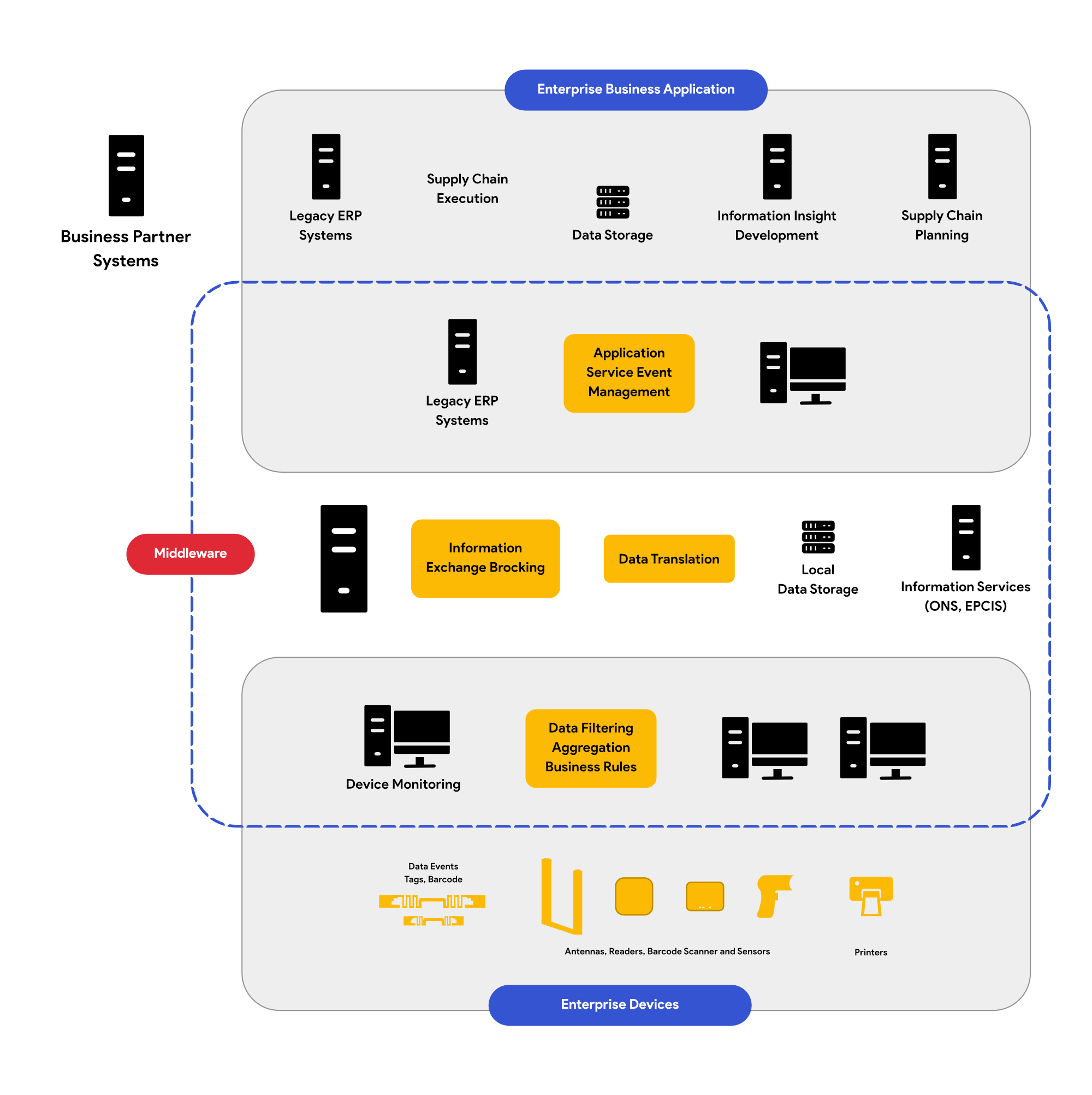Explore / RFID Basics & Resources
RFID Basics - What is RFID?
Radio Frequency Identification (RFID) technology belongs to a broader group of technologies known as Auto Identification (Auto-ID).
Auto-ID Technology
An Auto-ID technology is anything that collects data about the objects and enters that data into a database without human intervention. Auto-ID technologies are everywhere, quietly and efficiently doing thousands of mundane jobs. The one big job where Auto-ID makes a natural fit is in answering some of the big questions of commerce: “What is it?”, “Where is it?”, and “What about it?” – primarily the identification and tracking of boxes, people, animals, you name it! Compared to humans, Auto-ID technologies identify and track faster, more accurately and at a reduced overall cost. RFID is only one of many types of Auto-ID technologies. Other Auto-ID technologies include Magnetic Ink Character Recognition (MICR), magnetic strip, voice recognition, biometrics, and barcodes.
What is RFID?
RFID encompasses technologies that use electromagnetic (radio) waves, part of electromagnetic spectrum, to identify individual items, places, animals, or people. RFID can be appropriately implemented for many different uses. The most common is to use an identifying number (sort of a name) that uniquely identifies an object, place, animal, or person. The number is stored on an integrated circuit (IC) that is attached to an antenna. Together, the IC and the antenna are called an RFID transponder or tag. The tag is attached to the object, place, animal, or person to be identified. A device called the interrogator or reader communicates with the tag and is used to read the identifying number from the tag. The reader feeds the number it reads into an information system, which stores the number in its database or searches its database for the number and returns information stored therein about the object, place, animal, or person. The major difference between various Auto-ID technologies is in how the identifying number is stored and retrieved.
RFID Versus Barcode
Among the Auto-ID technologies mentioned so far, the barcode is closest to RFID; therefore, the two technologies are compared here to help you understand their relative advantages and disadvantages.
RFID is not necessarily “better” than barcode. The two are different technologies that have different, yet sometimes overlapping, applications. The big difference between the two is that barcodes require a line-of-sight, while RFID does not.
Many people think that RFID will replace barcodes, but if this happens, it will take several years since barcoding is a mature technology and currently has a very low cost of implementation compared to RFID. The table below lists major differences between the technologies.
RFID
- No line of sight required
- Uniquely identifies items, cases, pallets
- Item orientation to reader not important
- Simultaneous identification
- Dynamic read/write capability
- Can be used in harsher environment
- More data storage capacity
- Worldwide standards still in process
- More expensive: $0.10-plus cost to attach
- Currently requires two steps: tag creation and tag attachment
BARCODE
- Line of sight required
- Identifies only item category
- Requires proper orientation
- Scans only single item at a time
- No write capability, static information
- Soiled labels are difficult to read
- Limited data storage capacity
- Worldwide standards in place
- Cheaper to produce: $0.001
- Single step: can be easily printed on boxes during manufacturing
Brief History of RFID
RFID is called a new technology, but it is actually older than barcodes. The technology that forms the basis for RFID was first developed during World War II to identify airplanes. At that time, it was called friend-or-foe technology and a greatly modernized version is still used in aircraft identification today. Barcodes were invented in the late 1940’s but did not see substantial use until the late 1960s and early 1970s. However, barcode’s low price compared to RFID made it a much more attractive option for Auto-ID usage at that time. Well, at least if you were not trying to identify an airplane! But as the cost of RFID slowly dropped industry began to use it for more applications. Since 1979, RFID has been in use to identify and track animals. In 1994, all rail cars in the United States used RFID tags for identification. A recent surge has occurred in RFID technology research, manufacturing, and usage due to the advances in semiconductor manufacturing, which has reduced the cost of RFID, making their use economically feasible in supply-chain and other applications where tags are attached to objects not normally returned to the manufacturer.
RFID systems in the past used proprietary technologies; no worldwide open standards existed. There was little or no interconnectivity between different RFID vendor’s products. Every vendor had their own readers, tags, signals, and equipment¾and nothing worked together. This lack of interoperability made it challenging for companies to adopt RFID and constrained the deployment of RFID technology in the global supply chain. However, that problem is quickly disappearing due to new standards. Since 2006, many international and industry organizations have created open standards. RFID equipment manufacturers have started selling tags and readers that confirm to these new standards, resulting in an increase in the supply and a reduction in the price of RFID devices, which in turn has accelerated RFID technology adoption.
RFID Systems
RFID may only consist of a tag and a reader but an RFID system comprises many other technologies, such as computer, network, Internet, wireless devices, and software, all working with the RFID devices to create a complete solution. A typical RFID system is divided into two layers: the physical layer and Information Technology (IT) layer.
The physical layer consists of the following:
1. One or more RF tags
2. One or more interrogators (readers)
3. One or more reader antennas

The IT layer consists of the following:
1. One or more host computers connected to readers (directly or through a network)
2. Appropriate software (device drivers, filters, middleware, databases, and user applications)

Benefits of RFID
One of the benefits of the RFID system is reduced human intervention. RFID helps collect data automatically while business processes are being performed. No special actions are necessary to collect data. This automation improves data quality, reduces data collection time, captures data in real-time, and reduces costs associated with poor data quality. Time and cost savings also occur because boxes need not be opened to scan items to collect data. Inventory information can be collected in real-time and items can be tracked in real-time. RFID can also be utilized to verify the origin of an item and thus help detect counterfeit items. With the reduced cost of collecting data, businesses can afford to collect data at more locations throughout a process. This provides finer visibility in the business process, helps fine-tune the business processes, and helps identify inventory losses due to theft and damage. You can write data to a tag so the information travels with the item and can be used by downstream business processes. You can also uniquely identify each instance of an item and scan multiple items at one time at a high speed, even in harsh environments.
RFID Applications
RFID technology can be used in a wide variety of industries that need to track objects, persons, or animals. A few of the examples of applications are listed below:
1. Manufacturing Track work in progress to identify and eliminate bottlenecks, and track finished goods, inventory levels, and locations
2. Automotive Engine immobilization system
3. Supply chain Shipping and receiving, warehousing, retail outlet, inventory management
4. Pharmaceutical Pedigree management, product authentication, documents for FDA
5. Healthcare Track patients, equipment, and services
6. Library and video store Track assets and rentals
7. Access control Track security badges
8. Finance Cashless payments
9. Entertainment Hospitality, amusement park, event management, and ticket sales and verification
10. Inventory Recall and return management
11. Document management Track documents in lawyers’ offices, hospitals, government offices
12. Transportation management Rail car and truck tracking, toll collection, vehicle theft detection, vehicle speed tracking
13. Sports Track timing
14. Livestock and wildlife Track animals
15. Airline industry Track baggage